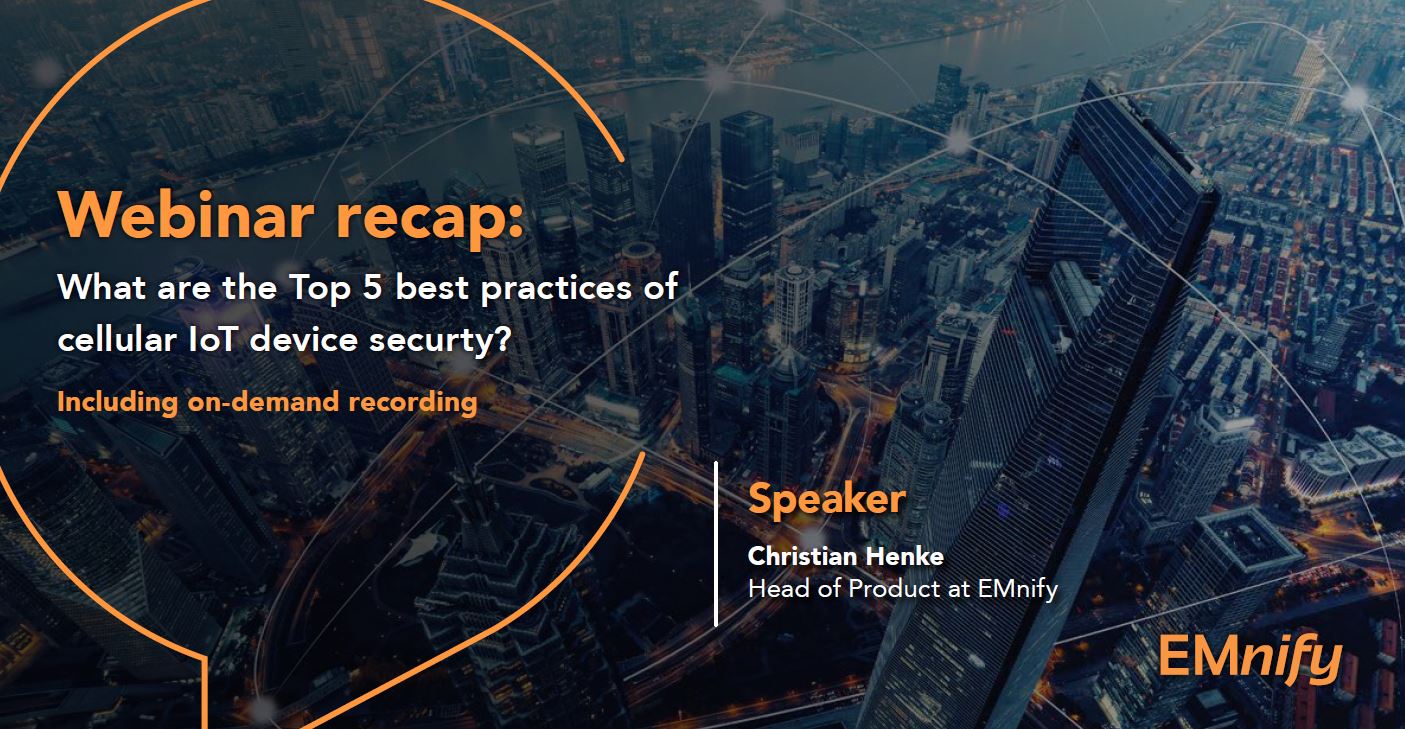

For our recent webinar in EMnify IoT Series we have invited Isabelle Sourmey from Saft. Saft is a French battery manufacturer, with a Connected Energy Division that specializes in IoT batteries. In this webinar Isabelle gives an overview of battery technology, starting with the components of the battery and explaining which requirements a battery for cellular IoT needs to fulfill - and where there are pitfalls when selecting the right one.
Watch the full recording, download the slides or read the key takeaways below.
1. Battery basics
While batteries come in different size and shapes, they have all the same structure and the same chemical principle:
Battery components
- anode - a negative active material that gives electrons
- cathode - a positive active material that receives electrons
- separator - insulate the cathode from the anode
- electrolyte - which allows the ions to move.
- a sealed container - that protects the chemistry
Battery constructions
1. Bobbin construction:
- Lithium metal at the outside, separated from carbon catalyst in the inside
- Bobbin are made for very long life (high energy capacity), for low current applications (few mA)
2. Spiral Construction
- Lithium / separator and carbon catalyst rolled in an electrolyte, so it is a layered spiral
- high power (more current) but lower energy density
2. Battery types for cellular connectivity from a voltage perspective
There are several chemical types of batteries - for rechargeable and non-rechargeable (also called primary) batteries. Well-known types in the consumer world are: Alkaline, Ni-Mh, Ni-Cd (all below 2V). For cellular modules and electronics, the voltage usually needs to be above 2.5V or even 3V+ so that the module can send data.
The voltage of a battery is dependent on the cathode and anode materials - the stronger the material couple (the farther left or right in the periodic table) the higher the voltage. That is why for example, primary chemistry LiMnO2, LiSO2, and LiSOCl2 have a high voltage. When choosing only one battery for electronics application, basically Lithium-based batteries are the only choice. Lithium batteries also provide low self-discharge, long life, and a stable voltage.
Rechargeable or non-rechargeable batteries (primary)
Primary batteries have clear advantages from an operation perspective - you only deploy once and can forget, whereas rechargeable batteries need extra equipment and need to be maintained. Interestingly in the IoT use case with very low current <1A - primary batteries may outlast rechargeable ones.
Comparing LPWAN battery life from a capacity perspective - LoRa, NB-IoT, LTE-M and GSM
IoT connectivity comes with different technologies. Assuming one transmission per day LoRa offers the best power profile (~130mAh per year) which allows AA batteries to last for more than 10 years, in favorable conditions of temperature and adapted cut-off voltage. For LTE-M and NB-IoT, the power profile is about 250mAh to 300mAh per year - which means an A, C or D type cell needs to be chosen to reach the 10-year goal, again, when cut-off voltage and temperature conditions are favorable. For 2G, 3G the consumption per year is above 4000mAh - and there is no battery that has this capacity over 10 years - so multiple batteries need to be combined.
3. Things to consider when selecting the battery
When just comparing basic information such as voltage and capacity batteries look similar, but they are quite different. Battery datasheets might be helpful when comparing batteries, but one has to be able to interpret the data - especially the voltage and capacity curves in dependency of discharge current and temperature. Beware that the datasheet may not show all discharge curves for all current levels: at some point in your development, you will have to contact the battery manufacturer.
The voltage level at a different temperature, current discharge, and age
The higher the current that is drawn from the battery and/or the colder the battery - the less elevated is the voltage level of the battery. As the cellular module only operates in a certain voltage range it needs to be ensured that under the working condition (current + temperature) still, the voltage readings will stay above the min. voltage. Further the age of the battery has an influence which is usually undocumented, and testing is required to detect potential low voltage behavior of the battery.
Battery capacity at different discharge current and temperature
. A battery will be able to deliver its nominal energy only under conditions of discharge current level, temperature range. And if the cut-off voltage of the electronics is above 3 V, there will be some remaining energy inside the battery once the cut-off will be reached.
Compliance to battery safety standards and transportation of batteries
When selecting the battery, one needs to ensure that safety and transportation standards are fulfilled. Because Lithium batteries are classified as dangerous goods, transport, handling, and disposal of the Lithium batteries need to be carefully managed.
4. Summary and key takeaways
Based on the presentation there were 5 key takeaways:
- Non-rechargeable batteries may last longer than rechargeable ones
- Choice of the connectivity has a huge impact on the battery solution
- Knowing accurately the device power consumption is important to select the battery
- Knowing accurately the environment (temperature) is important
- There is no one size fits all solution
Thank you for reading! If you have any questions, or want to find out more - feel free to drop us an email or reach out to Isabelle Sourmey from Saft directly. Don't forget to check out Saft's blog for trending and interesting content about IoT.

Christian Henke
If you want to understand how emnify customers are using the platform Christian has the insights. With a clear vision to build the most reliable and secure cellular network that can be controlled by IoT businesses Christian is leading the emnify product network team.



